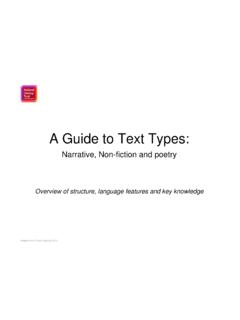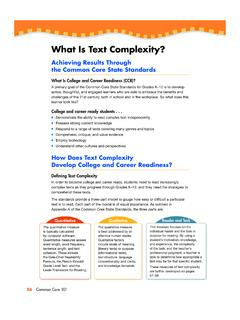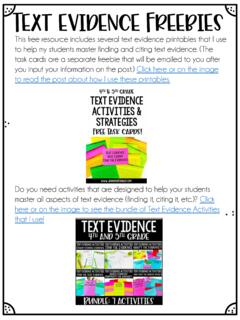Transcription of A Close Look at Close Reading - NIEonline
1 A Close Look at Close Reading Scaffolding Students with Complex texts Beth Burke, NBCT Table of Contents What Is Close Reading ? .. 2 Selecting a Text .. 3 What Makes Text Complex? .. 4 Steps in Close Reading .. 5 Scaffolding Students in Close Reading .. 6 Close Reading Template .. 7 Close Reading Sample Lesson .. 8 Spelunking (article) .. 9 Text Dependent Questions .. 10 1 What Is Close Reading ? Close Reading is thoughtful, critical analysis of a text that focuses on significant details or patterns in order to develop a deep, precise understanding of the text s form, craft, meanings, etc.
2 It is a key requirement of the Common Core State Standards and directs the reader s attention to the text itself. Close Reading includes: Using short passages and excerpts Diving right into the text with limited pre- Reading activities Focusing on the text itself Rereading deliberately Reading with a pencil Noticing things that are confusing Discussing the text with others o Think-Pair Share or Turn and Talk frequently o Small groups and whole class Responding to text-dependent questions 2 Selecting a Text Not every text is appropriate for students to read closely.
3 For example, while students enjoy Reading Diary of a Wimpy Kid books, these novels offer simple story lines and vocabulary that are easily understandable. When you are done Reading them, they don t leave you pondering deep ideas. Close Reading should leave you considering thought-provoking messages that go beyond the text. Close read-worthy texts include enough complex ideas worthy of exploring and discussing to sustain one or more days of instruction. According to Tim Shanahan, Close Reading is a multi-day commitment to a text; you want students to read a text that offers rich enough vocabulary, ideas, and information to read, examine, and discuss over those days without feeling like you re beating a dead horse.
4 When selecting a text, you need to consider the three components of text complexity: Qualitative measures, Quantitative measures, and the Reader and the Task. Each of these is equally important when considering the complexity of a text. Questions to consider: Qualitative Does this text offer ideas or information that further students understanding of the topic? Does the text include a text structure that .. Does the text follow familiar language conventions sentence structures, word choices, What background knowledge do my students need to have to be successful with this text?
5 Quantitative Is this text on an appropriate readability level for the students in my group? How can I scaffold my students to ensure their success with this text? *The primary leveling tool used by the Common Core is Lexile. For more information or to find the lexile of a text, visit Reader and Task Considerations How much prior knowledge do my students have about this topic? How interested are they? What will be difficult for my students in Reading this passage? Appendix B of the Common Core State Standards includes sample lists of exemplar texts that give you an idea of what complex texts look like in each of the grade level bands.
6 Motivation, prior knowledge, experiences, etc. 3 What Makes Text Complex? Close Reading should occur with appropriately complex text. There are a number of factors that contribute to text complexity. Teachers should differentiate, or vary, how they approach a text with students depending on the text complexity and students needs. Vocabulary o Academic and domain-specific terms o Tier 2 vocabulary: high utility complex words that can be used in multiple contexts Syntax Coherence Are the events and concepts logically connected and clearly explained?
7 Unity Do the ideas focus on the topic and not include irrelevant or distracting information? Audience appropriateness Does the text match the background knowledge of the target reader? Text structures Description Compare and Contrast Temporal Sequence Cause and Effect Problem and Solution Text features Headings/subheadings Signal words 4 Steps in Close Reading There is no specific sequence in a Close read; these steps are meant to generally guide you in crafting a lesson that scaffolds students and focuses on increasingly complex text dependent questions.
8 Begin with questions about the big ideas in the text and gradually ask higher level questions. 1. FIRST READ: KEY IDEAS AND DETAILS Set the purpose for Reading and have students read text as independently as possible. Depending on the text complexity and the readers, the first read may be done independently, as a read aloud/think aloud, or paired or shared Reading . The first read should be without building background; students should be integrating their background knowledge with the text as they read. Focus on the key ideas and details in the text, making sure that readers know the main idea, story elements, or key details that the author includes.
9 Following the first read, have students Think-Pair-Share to assess what they have gleaned from the text. By listening to students as they share, you can determine the focus of the first read, etc. 2. SECOND READ: CRAFT AND STRUCTURE For a second, Close read, select a portion or chunk of the text that is Close read worthy. That is, have students reread a section that includes complex elements or ideas that they should explore to arrive at a deep understanding of the text. After rereading, students discuss the text with partners or in small groups, focusing on the author s craft and organizational patterns.
10 This may include vocabulary choices, text structure or text features that they author included. Use a Text Dependent Question to focus or set a purpose for a Close rereading. After students share with partners or in small groups, have groups share out with entire class to assess understanding. 3. THIRD READ: INTEGRATION OF KNOWLEDGE AND IDEAS The third Close Reading of a text should go even deeper, requiring students to synthesize and analyze information from several texts or media. They may record their ideas on sticky notes, graphic organizer, or a thinking sheet.







